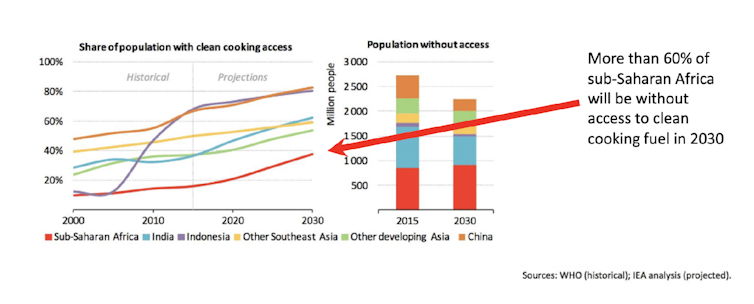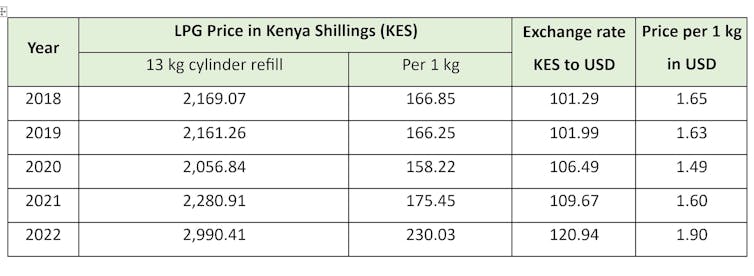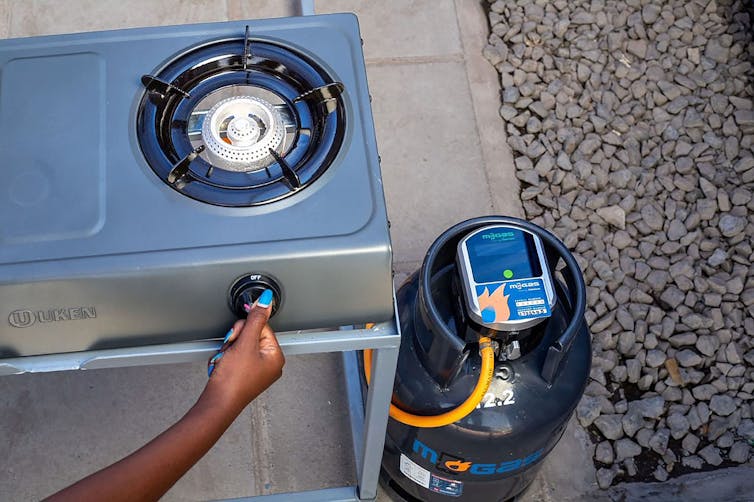
Africa’s growing population desperately needs clean, modern energy in the home. Currently, more than 900 million people, 85% of the region’s population, still rely on solid biomass fuel (like wood and charcoal) and kerosene for cooking. These energy sources are highly polluting, inefficient and unsafe.
Many African countries are moving to develop scalable renewable energy resources to fill the gap. These include solar PV, wind, hydro, geothermal, ethanol and biogas resources. The International Energy Agency has identified liquefied petroleum gas (LPG) as the most important interim clean cooking fuel during this transition. It’s the most practical, abundant and affordable among the current options.
LPG is a byproduct of oil and gas production and refining. Although it’s a fossil fuel, it’s one of the least damaging for the climate. It burns efficiently and has a high ratio of hydrogen to carbon, resulting in more energy for lower carbon emissions. Unlike wood and charcoal, LPG does not draw on forest reserves or contribute substantially to emissions of black carbon and methane, which are among the most powerful, short-acting climate warmers.
Time is fast running out to meet the UN’s global Sustainable Development Goal 7 for clean, reliable, sustainable and affordable energy by 2030.

This slow progress prompted the International Energy Agency in 2022 to set out what it calls the Sustainable Africa (energy) Scenario. This envisages that by 2030 one third of homes would be using LPG, 10% electricity, 10% biogas and 6% alcohol fuels. This leaves 41% still using solid biomass, but on more efficient, cleaner stoves.
But the acceleration required to reach even these projections is staggering. Clean cooking access in sub-Saharan Africa needs to improve around 15 times faster over the 2022-2030 period than it has before.
As experts on the impact of air pollution on public health, we argue that realistically, for the next 10-20 years, LPG is the only cleaner fuel that ticks all the boxes. It is popular, meets household needs, is easy to store and transport, and – crucially – is available now in the quantities needed.
Many African governments have already prioritised the rapid scale-up of LPG to secure cleaner cooking and forest protection, alongside active investment in renewables. So what’s the problem? Why aren’t more people in Africa using LPG when it’s cleaner and more efficient?
Barriers to LPG adoption
We examined this question through a review of 44 studies from Africa, Asia and Latin America. We investigated factors influencing the adoption of LPG, biogas, alcohol fuels and solar cooking. For LPG we identified affordability, reliability and convenience of supply, and fears about safety, as being most important.
Another worrying factor that’s emerged recently, and frequently reported to us by African country partners, is resistance from influential donor countries and their development institutions to invest in LPG because it’s a fossil fuel.

Support from these sources is so important. They can ensure their investments are linked to policy for creating the right market conditions, such as a well-regulated cylinder re-circulation system and improved storage and transport infrastructure. These are prerequisites for securing the much larger private sector investment needed for rapid LPG market expansion.
Addressing the barriers
Cost of LPG
The cost of acquiring an LPG cylinder and stove can be prohibitive for poorer homes. But cooking with LPG is typically no more expensive than buying wood, charcoal or kerosene.
Multiple factors can influence LPG prices, though, so they can fluctuate considerably. For instance, the Ukraine conflict forced up the cost of LPG in Kenya.

Government policy can help consumers. For example, value added tax on cylinder refills in Kenya was halved from 16% to 8% in July 2022 to encourage LPG use. And plans to reduce the VAT rate to zero were recently announced.
A potentially important innovation for managing the costs of cooking with LPG – under evaluation by our team in Kenya and Tanzania – is “pay-as-you-go” technology that uses smart meters and mobile money, like M-Pesa in Kenya. This allows poor households to buy only the amount of gas they need each day.

Reliability and safety of supply
Reliable, conveniently local and safe supply of LPG requires investment (to help businesses grow) and well-enforced regulation (to ensure best practices). The key to well-functioning LPG markets is adoption of the cylinder re-circulation model. This is when the marketing companies that distribute and sell LPG are also responsible for the safety of their branded cylinders.

Under this model, when customers need more gas, they exchange the empty cylinder for a full one that has been checked by the marketer, and replaced if damaged. Many African countries are now adopting this model. Cameroon is one example where it has been working quite successfully for a number of years.
Reluctance of donors to invest
Concerns about LPG being a fossil fuel for clean cooking in Africa are currently misplaced, especially with progress towards meeting SDG-7 being so behind. There is mounting evidence that switching populations from solid biomass to LPG can bring substantial health benefits, while having minimal impact on climate warming, and protecting forest resources.
Policy should also be guided by principles of environmental justice. Compared to wealthy countries, Africa’s historical climate warming contributions are minuscule. Cooking with biomass is at least 60% more greenhouse gas intensive than with LPG. If any population group has a just claim to use a fossil fuel that offers substantial health benefits as the world decarbonises, it is Africa’s poor.
The international community should move rapidly to support African governments in securing widespread adoption of LPG for clean cooking, alongside development of renewable alternatives that can progressively displace fossil-derived fuels. This “twin-track” approach can help make universal access to clean, efficient and modern energy by 2030 a reality, without threatening the world’s vital targets to limit global warming.
Les auteurs ne travaillent pas, ne conseillent pas, ne possèdent pas de parts, ne reçoivent pas de fonds d'une organisation qui pourrait tirer profit de cet article, et n'ont déclaré aucune autre affiliation que leur organisme de recherche.
This article was originally published on The Conversation. Read the original article.







